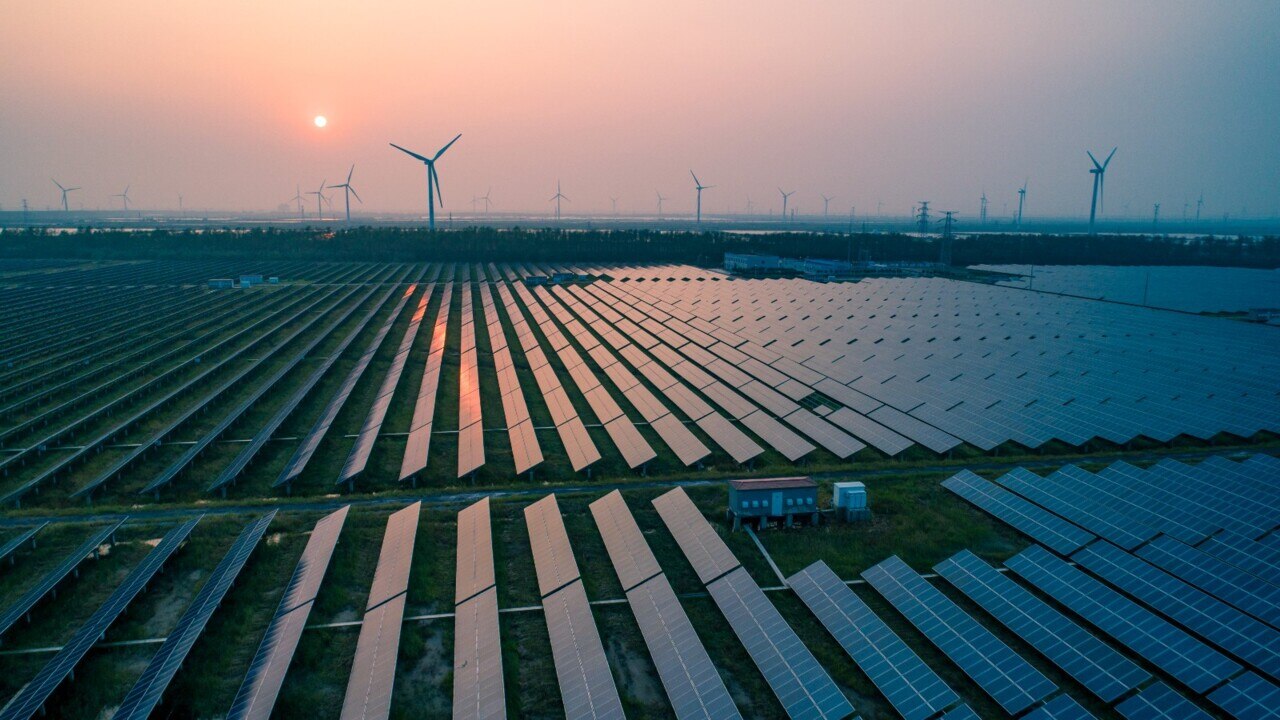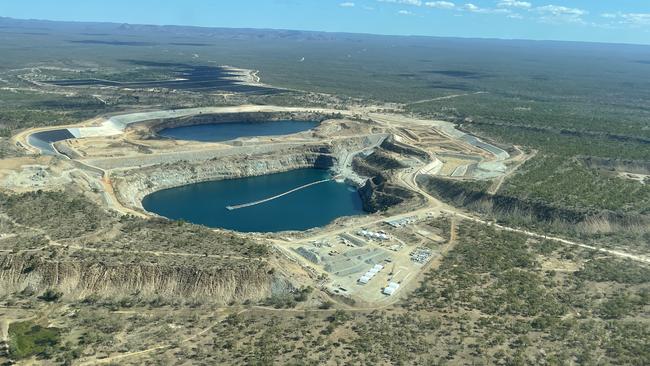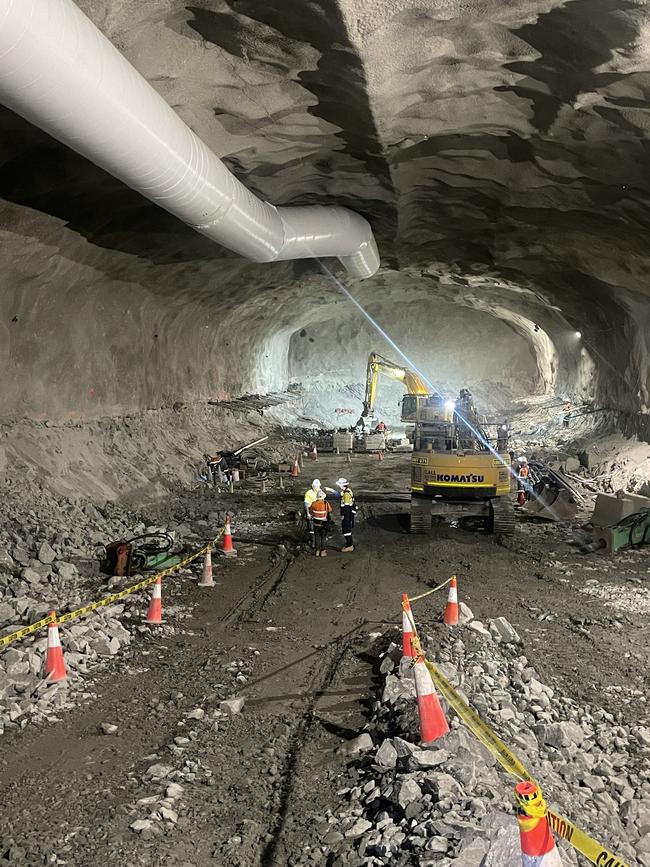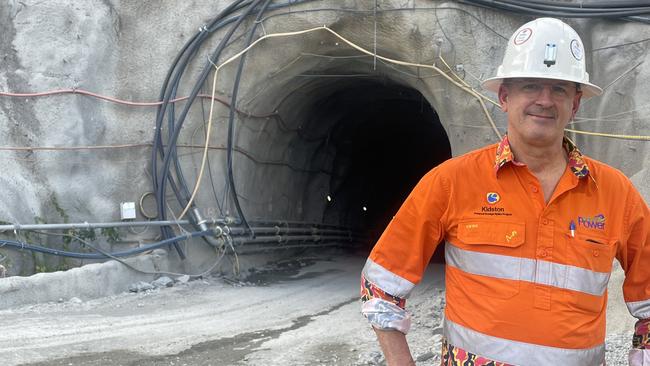Pumped hydro scheme strikes gold in outback Queensland
More than 200 metres beneath the rough-hewn grazing lands of Far North Queensland, Australia’s renewable energy future is being blasted out of the hard granite rock.

Business
Don't miss out on the headlines from Business. Followed categories will be added to My News.
More than 200m beneath the rough-hewn grazing lands of Far North Queensland, Australia’s renewable energy future is being blasted out of the hard granite rock.
For the past two years a network of tunnels and caverns has been excavated below two reservoirs, the remnants of the old Kidston gold mine, at a rate of 6m a day.
The huge underground space will eventually house two giant hydro-electric turbines powerful enough to light up a city the size of Townsville.
Genex’s Kidston Clean Energy Hub, which includes pumped hydro, solar and wind generation, has been almost $800m and a decade in the making but could signal a new wave of investment in big-ticket hydro energy projects.
Kidston is the only private pumped hydro scheme in the country and the first new pumped hydro project in 40 years.

Pumped hydro is an old technology, harking back to Europe a century ago. Today it is increasingly finding a role in meeting peak energy demand and augmenting solar and wind power generation.
With 300 workers toiling round the clock to bring the project online as early as 2025, Genex chief financial officer Craig Francis is confident the project will be the first of many pumped hydro schemes around the country.
Visiting the site this week were executives from EnergyAustralia, which has an offtake agreement with Genex and is planning a similar pumped hydro project at Lake Lyell in NSW.
A proposed Pioneer-Burdekin pumped hydro project is expected to generate 5GW of power and underpins a $62bn push towards renewable generation by 2035.
Mr Francis likened pumped hydro to a giant water-filled battery. Water will be pumped up into the upper reservoir during the day when power costs are generally lower and then released at night to drive turbines when electricity demand is higher and attracts higher prices. The Kidston project will provide 250MW of generation, over eight hours storage, with a ramp-up time of less than 30 seconds.

Mr Francis said a major advantage of pumped hydro over a storage battery was batteries had an effective life of 20 years, while the various turbines and generators making up a pumped hydro scheme could last for 80 years.
That equipment is now arriving in pieces from Europe and Asia, ready for assembly at Kidston in what will be a complex engineering feat over the next couple of months. Everything from 110 tonne turbines to the smallest nut or bolt will have to make its way down more than 1.5km of service tunnels to where a huge cavern is being created for the underground powerhouse. At the same time as the equipment is being assembled, huge intake pipes are being drilled into the hard rock to supply more than 50 Olympic swimming pools of water per second to the twin turbines. Genex chief executive James Harding said the hub was unique in having hydro, solar and wind in the one location.

South of the hydro site a 50MW solar farm is already in operation at the clean energy hub. Commissioned in 2017 with an offtake agreement from the state government, the farm is built on the old tailings ground of the Kidston gold mine.
Feasibility studies into the planned 258MW wind farm on the hills above the solar project are now under way. The wind farm will be a 50-50 joint venture with Japan’s JPower, Genex’s second-biggest shareholder.
“Having all three generation sources in the one location is absolutely unique anywhere in the world,” Mr Harding said. “We also are not aware of anywhere where a pumped hydro is located at an old gold mine.”
The Kidston mine operated between 1921-45 and 1984-2000 and at one stage was the country’s largest open cut gold mine. The mine’s historic battery and other abandoned buildings remain on site but were heavily damaged in a cyclone a few years ago.
Mr Francis said the project’s relatively remote location, 380km northwest of Townsville, meant it had not faced opposition that other energy projects encountered. But the drawback was the investment required to link the project to the rest of the national grid. A 186km long transmission line between Kidston and Mount Fox, northwest of Townsville, will be built to distribute power from the project to the national electricity market.
More Coverage
Originally published as Pumped hydro scheme strikes gold in outback Queensland





